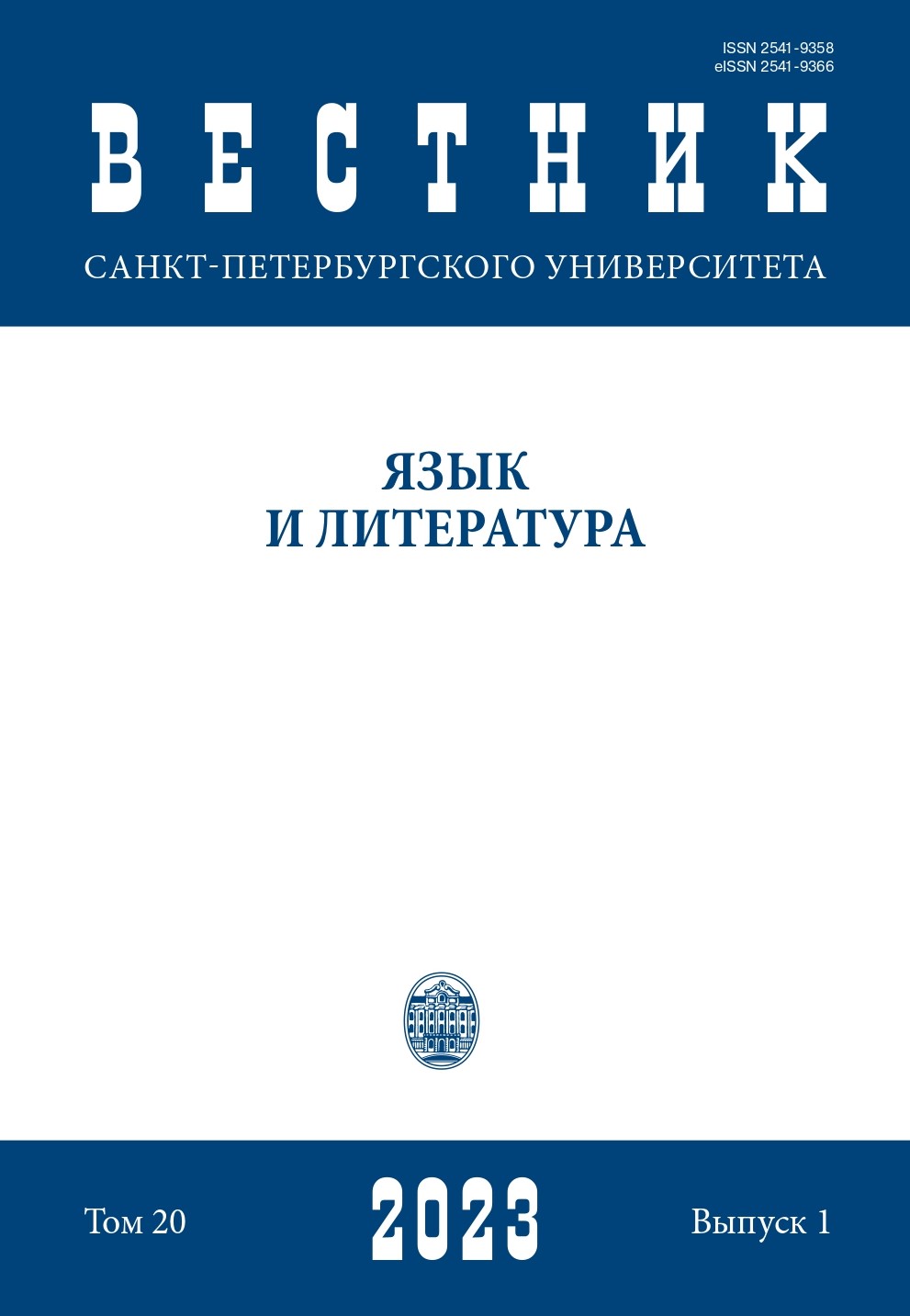Slovak temporal adverbs mnohokrát and veľakrát, the specificity of lexical meaning according to compatibility data
DOI:
https://doi.org/10.21638/spbu09.2023.102Abstract
The article considers the issue of synonymy/quasi-synonymy of the Slovak temporal adverbs mnohokrát and veľakrát, which belong to the semantic group “often”, based on the material of the Slovak National Corpus. The meaning of the lexemes included here assumes that a certain situation is repeated, and the speaker considers the number of such repetitions to be high. The analysis is carried out on the base of the compatibility of these adverbs in the Corpus. First, the indicators of the logDice association measure (the distance between collocates from –6 to 6 tokens) are considered, it is shown that the lists of words ranked by this measure are mostly the same for both lexemes, veľakrát has a certain specificity, which has a high degree of association with adverbial modifiers marking an extremely high frequency of a situation, or with constructions suggesting a detailed explication of its causes. The frequency context of the appearance of both adverbs in the text is thus a comparison of the real state of affairs with the desired one. In the second part of the article, the joint occurrence of adverbs from this semantic group is considered, including the compatibility of mnohokrát and veľakrát with the more frequent adverbs často and neraz. In this case, mnohokrát and veľakrát are used either for a detailed explication of the state of affairs, or to indicate directly observed situations. As follows from the analysis, the adverbs mnohokrát and veľakrát are almost complete synonyms, the difference between them is that the specified specificity of the meaning (high frequency of repetition, direct observability) is more pronounced in veľakrát than in mnohokrát.
Keywords:
temporal vocabulary, semantics, compatibility, Slovak language, association measures
Downloads
References
Литература
Ващенко 2021 — Ващенко Д. Ю. Словацкие темпоральные наречия čoskoro, onedlho, o chvíľu: к вопросу о квазисинонимии. Вестник РГГУ. Сер.: Литературоведение. Языкознание. Культурология. 2021, 2 (3): 10–31.
Захаров, Масевич 2014 — Захаров В. П., Масевич А. Ц. Информационные технологии в лингвистических исследованиях: учеб. пособие. СПб.: Филол. фак. С.-Петерб. гос. ун-та, 2014.
Панков 2009 — Панков Ф. И. Функционально-коммуникативная грамматика русского наречия: автореф. дис. … канд. филол. наук. М., 2009.
Dice 1945 — Dice L. Measures of the Amount of Ecologic Association Between Species. Ecology. 1945, 26 (3): 297–302.
Kesselová 2017 — Kesselová J. Osobné zámeno ja ako prostriedok personálnej deixy v dialogickej komunikácii v slovenčine. Вісник Дніпропетровського університету. Сер.: Мовознавство. 2017, 11 (23 (1)): 46–54. (На словацк. яз.)
Majchráková 2010 — Majchráková D. Štatistické metódy vyhľadávania verbo-nominálnych kolokácií v korpuse a analýza kolokačných mier. In: Varia XVII. Zborník materiálov zo XVII. kolokvia mladých jazykovedcov (Liptovská Osada — Škutovky 7–9.11.2007). Bratislava, 2010. S. 313–321. (На словацк. яз.)
Rychlý 2008 — Rychlý P. A lexicographer-friendly association score. Proceedings of Recent Advances in Slavonic Natural Language Processing, RASLAN. Sojka P., Horák A. (eds). Brno: Masaryk University, 2008.P. 6–9.
Stefanowitsch 2020 — Stefanowitsch A. Corpus linguistics. A guide to the methodology. Berlin: Language Science Press, 2020.
References
Ващенко 2021 — Ващенко Д.Ю. Slovak temporal adverbs čoskoro, onedlho, o chvíľu: а case of quasi synonymy. Vestnik Rossiiskogo gosudarstvennogo gumanitarnogo universiteta. Ser.: Literaturovedenie. Iazykoznanie. Kul’turologiia. 2021, 2 (3): 10–31. (In Russian)
Захаров, Масевич 2014 — Zakharov V.P., Masevich А.C. Information technologies in linguistic research: a textbook. St Petersburg: Filologicheskii fakul’tet SPbGU Publ., 2014. (In Russian)
Панков 2009 — Pankov F.I. Functional and communicative grammar of the Russian adverb. Abstract of PhD Thesis in Philological Sciences. Moscow, 2009. (In Russian)
Dice 1945 — Dice L. Measures of the Amount of Ecologic Association Between Species. Ecology. 1945, 26 (3): 297–302.
Kesselová 2017 — Kesselová J. Osobné zámeno ja ako prostriedok personálnej deixy v dialogickej komunikácii v slovenčine. Vіsnik Dnіpropetrovs’kogo unіversitetu. Ser.: Movoznavstvo. 2017, 11 (23 (1)): 46–54.
Majchráková 2010 — Majchráková D. Štatistické metódy vyhľadávania verbo-nominálnych kolokácií v korpuse a analýza kolokačných mier. In: Varia XVII. Zborník materiálov zo XVII. kolokvia mladých jazykovedcov (Liptovská Osada — Škutovky 7–9.11.2007). Bratislava, 2010. S. 313–321.
Rychlý 2008 — Rychlý P. A lexicographer-friendly association score. Proceedings of Recent Advances in Slavonic Natural Language Processing, RASLAN. Sojka P., Horák A. (eds). Brno: Masaryk University, 2008. P. 6–9.
Stefanowitsch 2020 — Stefanowitsch A. Corpus linguistics. A guide to the methodology. Berlin: Language Science Press, 2020.
Downloads
Published
How to Cite
Issue
Section
License
Articles of "Vestnik of Saint Petersburg University. Language and Literature" are open access distributed under the terms of the License Agreement with Saint Petersburg State University, which permits to the authors unrestricted distribution and self-archiving free of charge.






